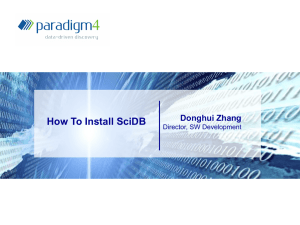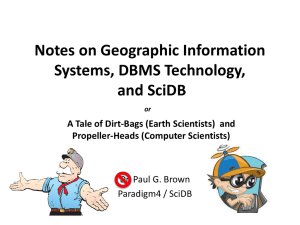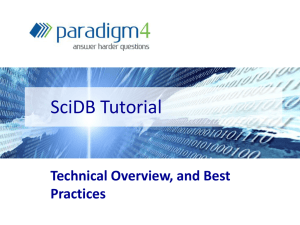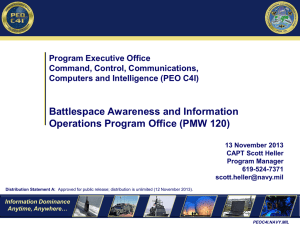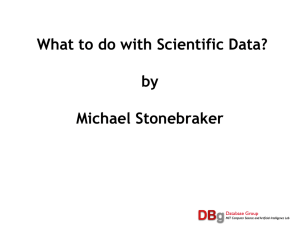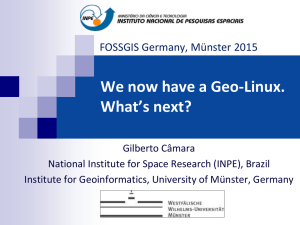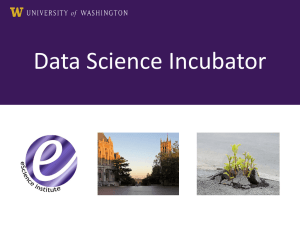MalonACATSciDB1
advertisement
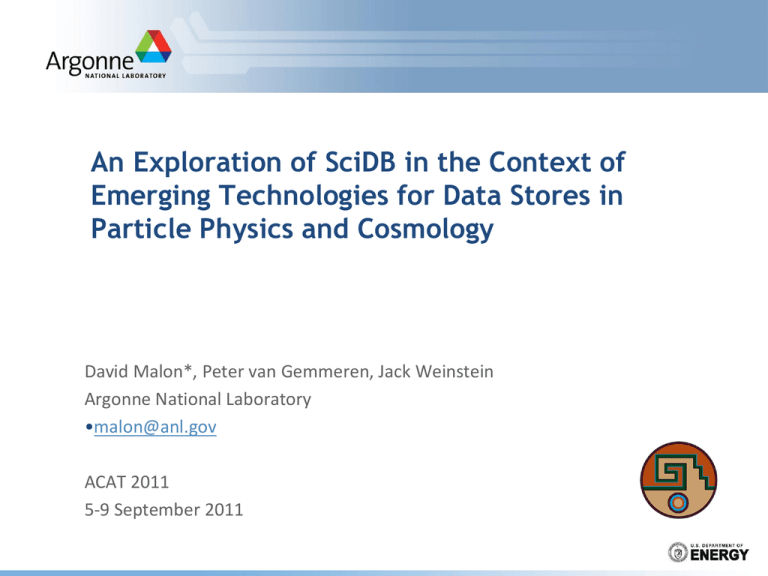
An Exploration of SciDB in the Context of
Emerging Technologies for Data Stores in
Particle Physics and Cosmology
David Malon*, Peter van Gemmeren, Jack Weinstein
Argonne National Laboratory
•malon@anl.gov
ACAT 2011
5-9 September 2011
Disclaimers and acknowledgments
Initial explorations of preliminary, “pre-alpha” releases of SciDB were conducted
at Argonne in 2010, but …
With a “real” release of SciDB available for the first time in June 2011, most of
those early tests were redone and the bulk of the work described herein was
undertaken by an Argonne summer student, Jack Weinstein, now at University of
Illinois at Urbana-Champaign
– Supervised by Peter van Gemmeren
– Jack should be giving this talk … but classes have begun
Thanks too to the SciDB team for two or three of their slides included in this
presentation
Misunderstandings and misrepresentations are entirely mine
David Malon
ACAT 2011
2
Emerging database technologies and HEP
HEP community uses databases extensively for a very wide range of purposes
The community has developed its own technologies to address many databaserelated problems that the database research community has also been thinking
about—usually for good reasons
– Temporal databases? COOL
– Distributed database content caching? FroNTier
– …
To many computational science applications in HEP, though, databases remain a
less-than-good match for a variety of reasons
Even for structures as simple as event-level metadata records, databases tend to
be deficient
– Scalable support for variable-length structures (e.g., information about varying numbers
of jets, leptons, …, in each event)
– Combinatorial operators
– Decoding time-varying information (e.g., trigger decisions: same triggers aren’t used in
every run) requires work
David Malon
ACAT 2011
3
Even as the HEP database “software stack” for
LHC-era experiments has gradually emerged, what
else has been going on?
Database technologies are evolving
Column-wise databases are now not at all unusual
Temporal database technologies have improved
Distributed and replicated database approaches are everywhere
HEP data scales are no longer rare, and others are addressing such data volumes
–
inside and outside of databases
People are thinking about database access in cloud computing
Are there emerging database technologies that the HEP community should be
tracking?
David Malon
ACAT 2011
4
SciDB: some history
A couple of years ago, some of the biggest names in database academe asked
themselves why big sciences aren’t using databases for their primary data
Aware of history; some of them were integrally involved
– Pick your favorite limited success (or failure) story
Of the many reasons for lack of success, things they heard repeatedly were
– Need for arrays—hard to emulate in RDBMS—and even nested arrays
– Lack of features: provenance, version control, internal support for uncertainty (error
bars on data), …
– Operations mismatch with SQL
Seek to address the “need for a scalable open-source data management system
with integrated analytics to support scientific research on massive data sets”
SciDB is born
David Malon
ACAT 2011
5
Preserving ordering helps complex computations
Relational Database
Paradigm4
I
0
1
2
3
0
1
2
3
0
1
2
3
0
1
2
3
J
0
0
0
0
1
1
1
1
2
2
2
2
3
3
3
3
value
32.5
90.9
42.1
96.7
46.3
35.4
35.7
41.3
81.7
35.9
35.3
89.9
53.6
86.3
45.9
27.6
32.5
90.9
42.1
96.7
46.3
35.4
35.7
41.3
81.7
35.9
35.3
89.9
53.6
86.3
45.9
27.6
Speeds up data access in a distributed
database
Facilitates drill-down & clustering by
like groups
Math functions like linear algebra run
directly on native storage format
Array Data Model
Nested multi-dimensional arrays
–
Cells can be tuples or other arrays
Time is an automatically supported
extra dimension
Extensible type system
Ragged arrays allow each
row/column to have a different
dimensionality
Support for multiple flavors of ‘null’
– Array cells can be ‘EMPTY’
– User-definable, context-sensitive
treatment
Data Storage
Arrays are “chunked” (in
multiple dimensions) in
storage
Chunks are partitioned
across a collection of nodes
Each node has processor
and storage (shared nothing)
Chunks have ‘overlap’ to
support neighborhood
operations
David Malon
ACAT 2011
8
Architecture
Shared nothing cluster
– 10’s–1000’s of nodes
– Commodity hardware
Queries refer to arrays as if not
distributed
Query planner optimizes queries for
efficient data access & processing
Query plan runs on a node’s local
executor/storage manager
Runtime supervisor coordinates
execution
SciDB Coordinator Node
SciDB
Engine
1
SciDB Client
2
3
PostgreSQL
Persistent System
Catalog Service
( iquery, Python )
Local
Store
PostgreSQL
Connections
SciDB InterNode
Communication
SciDB
Engine
SciDB
Engine
SciDB
Engine
SciDB
Engine
5
Local
Store
Local
Store
Local
Store
Local
Store
6
SciDB Node
SciDB Node
SciDB Node
SciDB Node
SciDB Worker Nodes
4
Query Language & Operators
Array Query Language -- AQL
–
Declarative SQL-like language extended for working with array data
Array Functional Language -- AFL
–
Functional language for internal implementation of the operators
Array Specific Operators
•
Aggregate, Apply, Filter, Join, Regrid, Subsample, et al
Linear Algebra, Statistical, and other applied math operators
–
Matrix operations, clustering, covariance, linear and logistic regression, et al
Extensible with Postgres-style user-defined functions
–
e.g., to ‘cook’ images, perform customized search, FFT, feature-detect
Interfaces to other open source packages
–
MatLab, R, SAS
Array Query Language (AQL)
CREATE ARRAY Test_Array
< A: integer NULLS,
B: double,
C: USER_DEFINED_TYPE >
[I=0:99999,1000, 10, J=0:99999,1000, 10 ]
PARTITION OVER ( Node1, Node2, Node3 )
USING block_cyclic();
attribute
names
A, B, C
index names
I, J
chunk
size
overlap
10
1000
David Malon
ACAT 2011
12
Array Query Language (AQL)
SELECT Geo-Mean
FROM Test_Array
WHERE
T.I BETWEEN
AND T.J BETWEEN
AND T.A = 10
GROUP BY T.I;
( T.B )
T
User-defined aggregate on an
attribute B in array T
:C1 AND :C2
:C3 AND :C4
Subsample
Filter
Group-by
So far as SELECT / FROM / WHERE / GROUP BY queries are
concerned, there is little logical difference between AQL and SQL
David Malon
ACAT 2011
13
But why should a proton collider experiment care
(or not) about SciDB?
Array-oriented operations with support for overlapping chunks—the focus of
initial SciDB development—is not what is most of interest to us
– Though in certain other domains (e.g., in astrophysics) this could be key
Same parallel execution architecture, though, and explicit design to support multipetabyte data stores, may help us
– As may its explicit support for sparse data
Design with a view of transactions that is aware of the write-once nature of most
of our data is interesting
SciDB plans to support in situ data, in addition to SciDB-native storage formats, are
very interesting
– Bulk data could be in a format known and proven within the community
– Initially, NetCDF/HDF5 proposed, but no reason that, say, a ROOT storage backend
could not be provided
Support for user-defined functions and types could be extremely useful
Provenance support (though initially primitive) is a plus
Support for uncertainty in data is interesting in principle
– A bit of skepticism, though, about how much this helps us in practice, may be in order
David Malon
ACAT 2011
14
So?
Shared-nothing architectures on commodity clusters?
– Make sense, but there are lots of products that do this
Array extensions to traditional SQL?
– Worthwhile idea for some data, but do they help in experimental particle physics when
array indices might be {run #, event #}, or {run #, event#, jet #}?
Focus of student project was not upon performance, but upon evaluation of
SciDB’s capability of supporting HEP data and data types, and natural operations
thereon
David Malon
ACAT 2011
15
Scope of the project
Install and configure first real release of SciDB, R11.06
Provide machinery to upload data from multiple source types, including
ROOT files
Exercise the user interface and operators
Explore tradeoffs in data organization
Evaluate sparse versus dense data representations of identical data
Provide user-defined types and functions in support of scientific data
types
David Malon
ACAT 2011
16
First, the data: event-level metadata from proton
collisions at LHC
ATLAS records key quantities describing properties of proton collision events as
event-level metadata
Metadata records contain information useful in event selection
– Including information about variable numbers of jets, photons, muons, electrons, …
– And triggers passed by the events
– Along with sufficient navigational information to allow one to navigate to file-resident
raw and derived event data for events that satisfy selection criteria
Chosen for early tests because data structure is relatively simple, and event-level
metadata records are already hosted both in files and in relational databases
– Variable-length array data members are not a natural fit to relational databases, though
they can be supported
– And queries may be complex and combinatorial
Data from 2011 ATLAS runs provided a basis for many of our tests
David Malon
ACAT 2011
17
More data: cosmological simulations
Data associated with cosmological simulations that can challenge the capabilities
of the largest leadership computing facilities in fact often have very simple
structure
– N-body problem(s)
– 8 floating point variables are stored for each particle (position, velocity, mass, id):
• x[Mpc], v_x[km/s], y[Mpc], v_y[km/s], z[Mpc], v_z[km/s], particle mass[M_sol], particle tag
Important derived data are not much more complex
(Dark matter) halo catalogs
– Halos are stored as halo_mass[10^10 M_sol], x[Mpc], y[Mpc], z[Mpc], vx[km/s],
vy[km/s], vz[km/s
Published reference datasets used in comparisons of cosmological simulations
were uploaded in our tests
– 256**3 particles
– Natural candidates for exploiting three-vector constructs for position and velocity
Uploads
New to SciDB: a Python “connector,” e.g.,
db = scidb.connect("localhost", 1239) # connect to the SciDB coordinator
db.executeQuery("drop array simplearray", 'aql') # execute an AQL query
Python script developed to upload data from ROOT trees to SciDB
– root2scidb.py
Also a script to upload (FORTRAN direct I/O) cosmology data
Bulk loads and parallel loading of chunks possible in principle
David Malon
ACAT 2011
19
User-defined types and functions
Several user-defined types and functions were defined as part of this
exercise
Three-vector type
Rotation functions
Lorentz vector type
Lorentz transformations
… and a variety of related operators
Examples:
– apply(AttributeList, Jet, threeVector(JetPt1, JetEta1, JetPhi1))
– sort(AttributeList, angleBetween(Jet1, threeVector(1,1,1)))
David Malon
ACAT 2011
20
Under the covers…
As usual when introducing a new type into a system, the tedious work is
not defining the data members (a struct of three doubles, say)
Rather, it is in
– Defining all the supporting operators, e.g., for construction and
assignment
– Registering the type so that it is recognized and its appropriate
associated operators invoked by the system into which it is introduced
– And so on
The following slides illustrate how this happens in SciDB
David Malon
ACAT 2011
21
UDT supporting machinery: declaration and
construction
David Malon
ACAT 2011
22
UDT supporting machinery
David Malon
ACAT 2011
23
First impressions
Initial development aimed principally at supporting array data models, both in
storage and in operations
– Array data structures, partitioning (chunking), overlap specification, and basic
operations thereon, are well underway
– Most testable features are currently of this flavor
For many sciences, this focus is entirely appropriate
Designed to be well suited to image data
– A major target client of SciDB is LSST
Other development has necessarily received less
emphasis to date
– Including some basic relational database features,
and planned non-array-oriented functionality
David Malon
ACAT 2011
24
Status and prospects
SciDB has advanced considerably in functionality and robustness since its earliest
incarnations
Most issues we encountered were minor, e.g.,
– Configuration still exhibits certain inflexibilities, and SciDB is not difficult to crash
– And we stop SciDB by broadcasting kill -9?
– Printout and other user interface features still primitive
Composition of functions works well, e.g.,
iquery -p 1341 -q "project(filter(subsample(AttributeList, 0, 20), NJet>0), 'NJet')”
Support for user-defined types and operators is functional, with some minor
limitations
– Limit of three arguments to type constructors
– Loading user-defined types requires conversion to string but works well enough
This is, of course, only a status snapshot, and continual improvement is expected
HEP applications can learn and profit from architectures such as that of SciDB
David Malon
ACAT 2011
25
Further work?
See also work by Nikolay Malitsky at Brookhaven National Laboratory, who is
investigating use of SciDB for EPICS (Experimental Physics and Industrial Control
System) data
And track SciDB and its applications at www.scidb.org
David Malon
ACAT 2011
26
